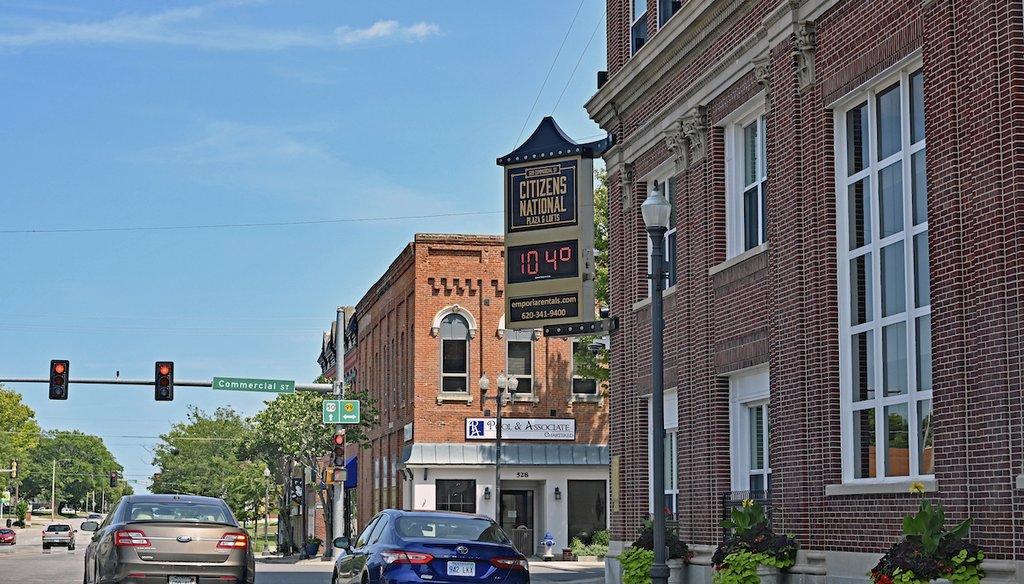Stand up for the facts!
Our only agenda is to publish the truth so you can be an informed participant in democracy.
We need your help.
I would like to contribute

A temperature marquee sign at a Citizens National Bank building reads 104 degrees on Aug. 2, 2022 in Emporia, Kansas. (AP/MediaPunch)
Fact-checking a talking point about ‘corrupted’ climate change data
If Your Time is short
-
There is widespread consensus that average temperatures are rising both in the U.S. and globally.
-
Although not all temperature stations are stationed in areas with ideal research conditions, experts said those that aren’t are maintained in order to provide a consistent historical record of temperature changes over time. The data is also evaluated and adjusted for potential biases.
-
Research does not reflect that data used from poorly sited temperature stations yields biased conclusions.
Global temperatures are rising, and there is ample evidence to support that fact.
But that hasn’t stopped some people from claiming they’ve found proof that climate change concerns are overblown. An article circulating on Facebook claims that U.S. agencies’ use of flawed data exaggerates the severity of climate change.
"96% of U.S. climate data is corrupted," reads the headline of one July 27 blog post from the Heartland Institute, a conservative think tank.
"Official NOAA temperature stations produce corrupted data due to purposeful placement in man-made hot spots," the blog post said, referring to National Oceanic and Atmospheric Administration data.
The post was flagged as part of Facebook’s efforts to combat false news and misinformation on its News Feed. (Read more about our partnership with Facebook.)
The Heartland Institute cited a report it paid for and produced. That report analyzed a small sample of 128 temperature stations out of several thousand volunteer-run stations and found that 96% of them failed to meet NOAA placement recommendations. It appears those findings were extrapolated to conclude that the placement of these temperature stations "strongly undermines" the legitimacy and magnitude of long-term climate change trends.
"The correct approach is to write a scientific paper and submit it to a scientific journal," said Zeke Hausfather, a climate scientist currently serving as research lead at Stripe, a San Francisco-based technology company. "In this specific case, the author of the report, Anthony Watts, submitted a paper on the topic around 10 years ago, but was unable to successfully convince other scientists of the validity of his findings and to pass the peer review process."
Donald J. Wuebbles, a professor of atmospheric science at the University of Illinois, characterized Watts as a "well-known climate denialist."
With that in mind, we set out to learn more about data collection and climate change.
How data is collected
Scientists, volunteers and automated instruments collect climate data such as air chemistry, temperature, precipitation and wind speed, according to NOAA. Instruments carried on balloons can provide data from points more than 10 miles high. Satellites track temperature, winds and clouds.
NOAA and the National Weather Service have two programs that monitor weather conditions in the U.S., said Robert Rohde, lead scientist at Berkeley Earth, a Berkeley, California, organization providing global temperature data.
One program, the Cooperative Observer Program (COOP), relies on more than 8,700 volunteers who record daily temperature data using weather monitoring equipment.
The other program is a network of about 900 more sophisticated, automated weather stations often set up in connection with airports or weather bureaus, Rohde said. The standards for installing those stations are more rigorous than Cooperative Observer Program stations, he said.
The Heartland report looks exclusively at 128 COOP stations of thousands. Rohde said that "immediately undermined" its conclusion that 96% of climate data is corrupt. It is unclear how those stations were selected.
According to National Weather Service instructions, COOP stations should be installed over level terrain at least 100 feet from "any extensive concrete or paved surface," and should not be placed where water or drifting snow collects.
Rohde said that some COOP stations are closer than recommended to structures, artificial surfaces or vegetation. "In the worst cases, local impediments may greatly disturb the temperature readings reported," he said, resulting in temperature readings "dominated by the surfaces and other features in the immediate vicinity of the sensor."
Going deeper into the data concerns
The Heartland report argued that such temperature stations, which might be placed near structures or parking lots, resulted in corrupted data.
But that allegation ignores key facts.
First, climate scientists know that weather station data can be impacted by poor siting, and they adjust data accordingly.
Second, climate change analysis focuses on changes over time.
"Siting problems often cause the station to be consistently a bit too hot, or too cold, but that bias often remains more or less uniform over time," Rohde said. "In such cases, it may still be possible to estimate trends related to climate change even if the observations themselves are not ideal."
Research has not proved that poor station siting results in biased conclusions, however.
A 2013 study found that the network of stations can provide reliable data on temperature trends even when stations rated "poor" are included.
NOAA spokesperson John Bateman told PolitiFact the agency has known about the concerns caused by problematic station sites for decades, and it has "developed techniques to account for and correct these potential problems."
The Heartland Institute told PolitiFact that its conclusions were valid because experts did not disagree that some COOP stations are at sites that fail to meet NOAA’s quality recommendations. The group argued that because of those stations, any methods used to adjust the data and remove bias would "actually make the problem worse."
Data is adjusted, corroborated and widely accepted
In 2009, NOAA acknowledged that the placement of a number of temperature stations did not follow National Weather Service siting recommendations. Still, a peer-reviewed 2006 study that sought to evaluate the potential bias caused by poor station locations "found no bias in long-term trends," NOAA said. That study evaluated a small subset of data, so its conclusions had limitations.
Researchers account for temperature station locations and measurement times, said Mark Richardson, a research scientist at the California Institute of Technology’s Jet Propulsion Laboratory who studies climate change. "So, even if a thermometer is in a warmer place, like a city, the effect of the local warmth is filtered out to prevent it from affecting trends."
NOAA publishes U.S. weather station data online, and groups such as Berkeley Earth, NASA’s Goddard Institute for Space Studies, the United Kingdom’s Met Office and the Japan Meteorological Agency use it to build climate records.
"The independent groups all agree about the pattern of U.S. and global temperature changes," Richardson said.
Since 1880, average global temperature has increased by at least 1.9 degrees Fahrenheit (or 1.1 degrees Celsius), according to Goddard Institute for Space Studies’ temperature analysis.
By way of comparison, Richardson said that the Earth cooled about 4 to 6 degrees Celsius tens of thousands of years ago and a nearly 4 kilometer thick mass of ice known as the Laurentide ice sheet spread over Canada and reached parts of the U.S.
Awesome visualization and a much-needed update to Laurentide Ice Sheet margins thru time! https://t.co/RUxxFhrI1k
— Dr. Katherine Glover (@gloverkatherine) March 11, 2020
"The warming rates we are living through are truly astonishing for Earth, even if they feel slow day to day," Richardson said.
These trends are corroborated by data from temperature stations that are not in poorly placed areas.
Wuebbles said satellite trends in temperature "exactly match the ground-based observations," but the Heartland Institute’s study does not analyze that corroboration.
Our ruling
A headline on Facebook claimed "96% of U.S. climate data is corrupted" because the NOAA’s temperature stations were purposefully placed "in man-made hot spots."
Although some temperature stations are not placed in ideal conditions, experts said they are there to provide a consistent historical record and added that the data is evaluated and adjusted for biases.
There is widespread consensus that annual global average temperatures are rising, experts said.
We rate this claim False.
RELATED: Kilimanjaro’s ice fields didn’t disappear by 2020. That doesn’t mean climate change isn’t happening
RELATED: What does extreme weather tell us about climate change?
Our Sources
The Heartland Institute, "96% of U.S. climate data is corrupted," July 27, 2022
Email interview with Donald J. Wuebbles, a professor of atmospheric science at the University of Illinois, Aug. 10, 2022
Email interview with Mark Richardson, research scientist at the California Institute of Technology’s Jet Propulsion Laboratory, Aug. 10, 2022
Email interview with Robert Rohde, lead scientist at Berkeley Earth, Aug. 12, 2022
Email exchange with Zeke Hausfather, climate research lead at Stripe, Aug. 10, 2022
Email exchange with John Bateman, public affairs officer for the National Oceanic and Atmospheric Administration, Aug. 8, 2022
Email exchange with Richard Muller, a physics professor at the University of California, Berkeley, Aug. 11, 2022
PolitiFact, "The Earth has rapily warmed over the past century. Can politics slow it?" Oct. 28, 2019
National Oceanic and Atmospheric Administration Climate Services, "Talking Points related to: Is the U.S. Temperature Record Reliable?" June 9, 2009
Climate Feedback, "NOAA does not fraudulently adjust data to create the illusion of a global warming trend," March 29, 2018
Berkeley Earth, "Understanding adjustments to temperature data," April 21, 2015
Enterprise Record, "Letter: Weather stations fail to meet standards," Aug. 5, 2022
Heartland Institute, "2022 Edition - Corrupted Climate Stations," Aug. 2022
NOAA Climate Services, "Talking points related to: ‘Is the U.S. Temperature Record Reliable’?" June 9, 2009
NASA Earth Observatory, "World of change: global temperatures," accessed Aug. 11, 2022
Advancing Earth and Space Science, "On the reliability of the U.S. surface temperature record," June 8, 2010
Geoinformatics & Geostatistics: An Overview, "Earth atmospheric land surface temperature and station quality in the contiguous United States," May 20, 2013
Nature, "IPCC climate report: Earth is warmer than it’s been in 125,000 years," Aug. 9, 2021
Carbon Brief, "Explainer: How data adjustments affect global temperature records," July 19, 2017
Climate Etc., "Understanding adjustments to temperature data," July 7, 2014
The Guardian, "No climate conspiracy: NOAA temperature adjustments bring data closer to pristine," Feb. 8, 2016
Climate Feedback, "NOAA does not fraudulently adjust data to create the illusion of a global warming trend," Feb. 19, 2020
The New York Times, "The science of climate change explained: Facts, evidence and proof," Nov. 6, 2021
National Oceanic and Atmospheric Administration, "Climate data monitoring," accessed Aug. 12, 2022
National Weather Service, "Cooperative Observer Program (COOP)," Aug. 12, 2022
National Weather Service, "Requirements and standards for NWS climate observations," April 20, 2018
NASA Global Climate Change, "The raw truth on global temperature records," March 25, 2021
The Washington Post, "Ted Cruz says satellite data show the globe isn’t warming. This satellite scientist feels otherwise," March 24, 20215
Scientific American, "It’s a match: Satellite and ground measurements agree on warming," April 18, 2019
Nature, "IPCC climate report: Earth is warmer than it’s been in 125,000 years," Aug. 9, 2021
National Weather Service, "Cooperative weather stations," accessed Aug. 18, 2022
Browse the Truth-O-Meter
More by Madison Czopek
Fact-checking a talking point about ‘corrupted’ climate change data
Support independent fact-checking.
Become a member!
In a world of wild talk and fake news, help us stand up for the facts.




































